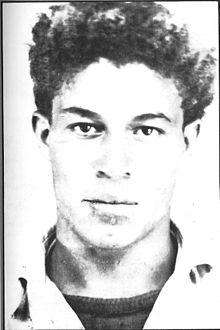Ali La Pointe
Ali Ammar (Arabic: علي عمار; 14 May 1930 – 8 October 1957), better known by his nickname Ali la Pointe, was an Algerian revolutionary fighter and guerrilla leader of the National Liberation Front who fought for Algerian independence against the French colonial regime, during the Battle of Algiers.
Ali Ammar | |
|---|---|
 | |
| Born | 14 May 1930 Miliana, Algeria |
| Died | 8 October 1957 (aged 27) Algiers, Algeria |
| Other names | Ali la Pointe |
| Occupation | Freedom Fighter |
| Organization | Armée de libération nationale (ALN) |
| Known for | Battle of Algiers |
| Movement | Front de libération nationale (FLN) |
Ali lived a life of petty crime and was serving a two-year prison sentence when war broke out in Algeria in 1954. Recruited in the notorious Barberousse prison by FLN militants, he became one of the FLN's most trusted and loyal lieutenants in Algiers. On 28 December 1956, he was suspected of killing the Mayor of Boufarik, Amédée Froger.
In 1957 French paratroopers led by Colonel Yves Godard systematically isolated and eliminated the FLN leadership in Algiers. Godard's counter-terrorism methods included interrogation with torture. In June, la Pointe led teams in setting explosives in street lights near public transportation stops and bombing a dance club that killed 17.[1]
Saadi Yacef ordered the leadership to hide in separate addresses within the Casbah. After Yacef's capture, la Pointe and three companions, Hassiba Ben Bouali, Mahmoud "Hamid" Bouhamidi and 'Petit Omar', held out in hiding until 8 October. Tracked down by paras acting on a tip-off from an informer, Ali La Pointe was given the chance to surrender but refused, whereupon he, his companions, and the house in which he was hiding were bombed by French paratroopers. In all, 20 Algerians were killed in the blast.[2]
He was portrayed by Brahim Haggiag in the film The Battle of Algiers.
Biography
Ali Ammar was born on 14 May, 1930 in Miliana, Algeria to a poor family. The family's financial situation did not allow him to attend school. His nickname "La Pointe" comes from the Point district in Miliana. While being imprisoned for the first time at the age of thirteen, he learned masonry. In 1945, he became known in Algeria for playing tchi-tchi, a type of gambling game scam, then as a pimp and acquired a sort of prestige. He was convicted for theft of military effects in 1943, rape in 1950, international assault and violence to an officer in 1952, and attempted homicide in 1953 and 1954.
In 1954, when the Algerian War broke out, he escaped from prison (the Prison de Barberousse) where he was serving a two-year sentence for attempted murder. FLN, Front de libération nationale (National Liberation Front), militants explained to him that Algiers was a victim of colonialism and recruited him to their cause. He later escaped again after being transferred to a prison in Damiette. He returned to Algeria and made contact a few months later with Yacef Saadi.
Activity within the FLN
In late 1955, Ali la Pointe was introduced to Yacef Saâdi, who was Larbi Ben M'hidi's superior and the chief of FLN for the Zone autonome d'Alger, an ALN-FLN compound during the Algerian War. Yacef Saâdi "decided to test him", trusting him with the execution of an informer on the evening of their meeting. Recruited, according to Marie-Monique Robin for his "formidable qualities as a killer", he became, according to Christopher Cradock and M.L.R. Smith, "the chief assassin" for FLN. He was notably responsible for what was referred to as a "line up of the Casbah underworld with the nationalist terrorist movement" from an article by The New York Times. After some figures of the local underworld who were suspected of being informants were executed, such as Rafai Abdelkader, said Bud Abbot and Hocine Bourtachi, he "sowed terror" in the casbah, according to Marie-Monique Robin.
References
- Randall Law Terrorism: A History section "French Success in the Battle of Algiers and Beyond" John Wiley & Sons 2013 ISBN 978-0745640389
- Universite Hassiba Ben Bouali (in French), archived from the original on 20 February 2008, retrieved 2 February 2011